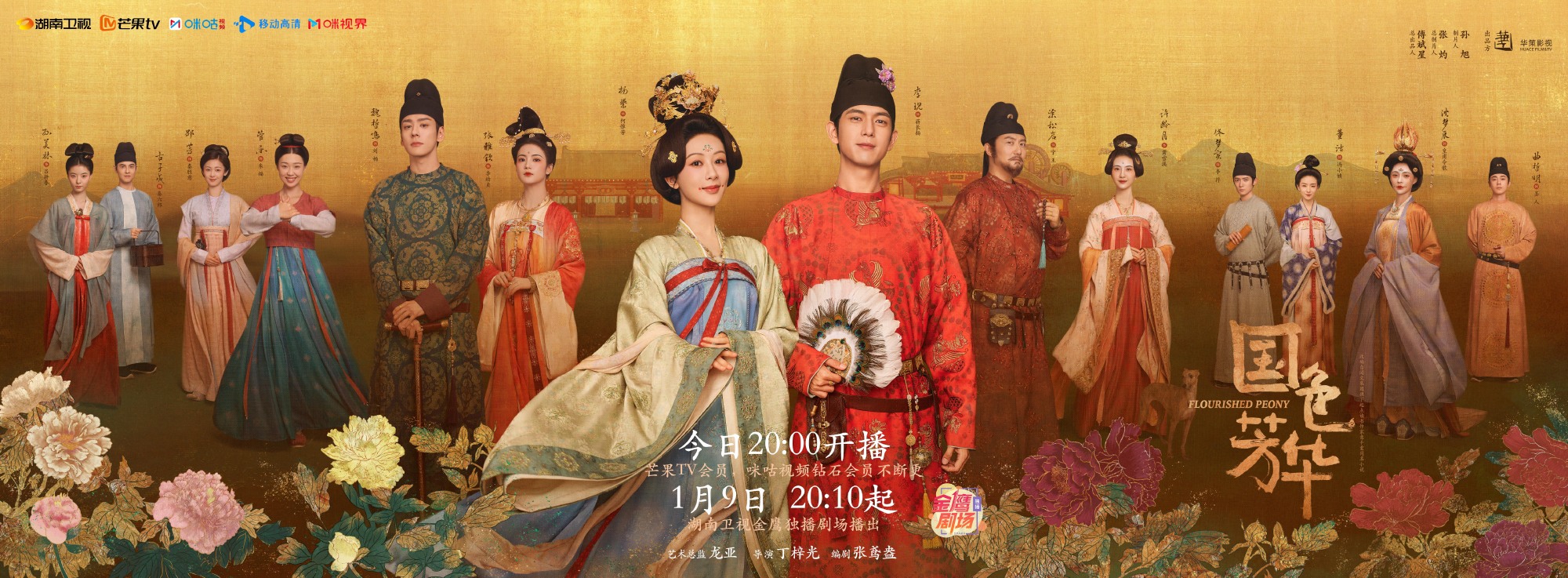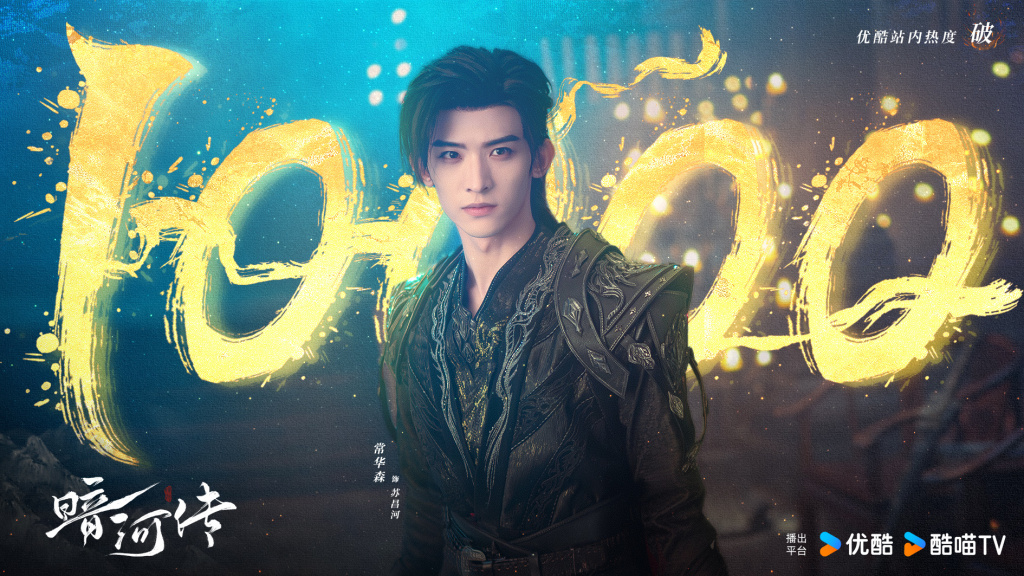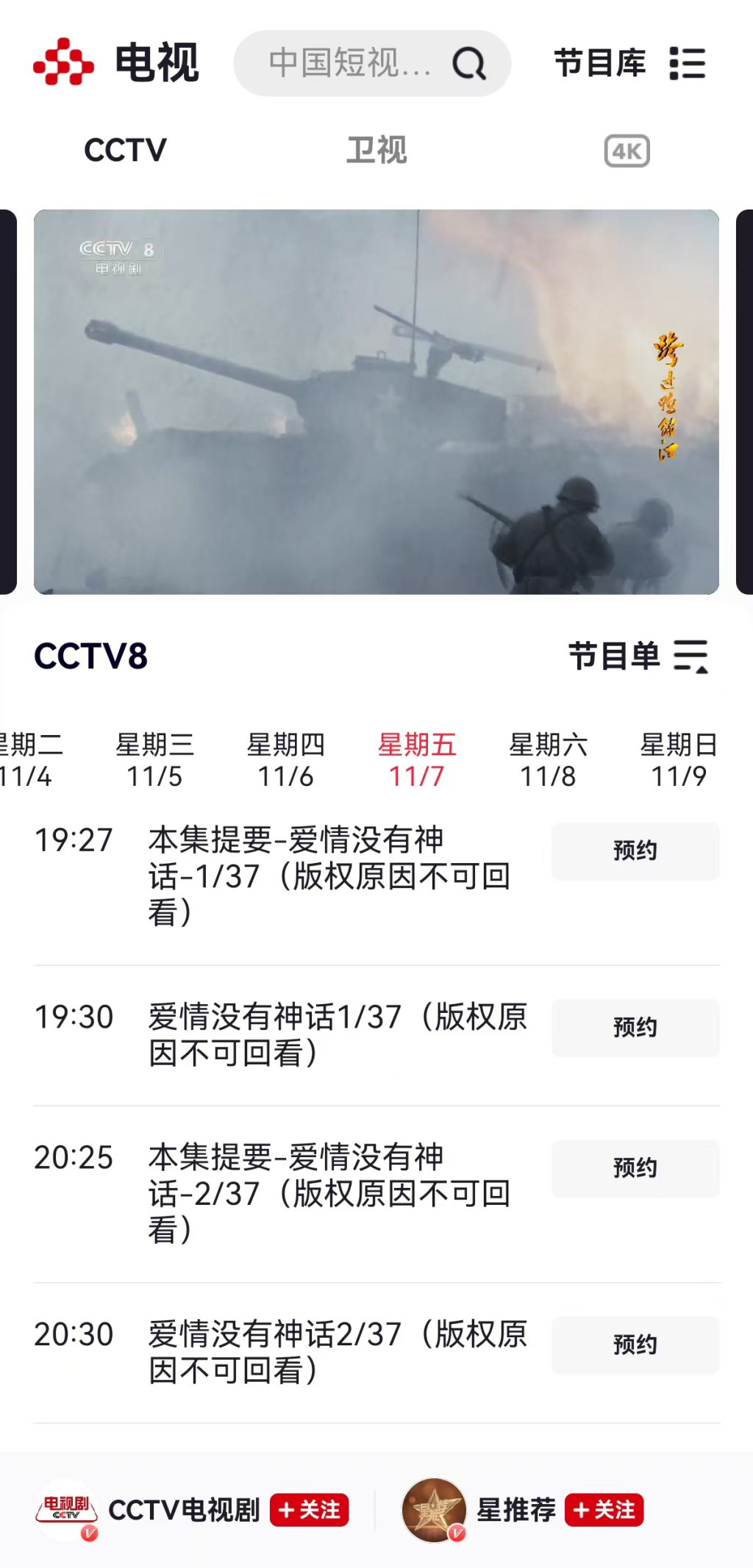
"Guo Se Fang Hua" and "Bai Yue Fan Xing" were broadcast on the same day. One is a costume drama with Yang Zi and Li Xian, which is rarely seen on Mango TV. The other is a costume fantasy drama with Bai Lu as the leading role, which has been in decline for a year. Both of them have been popular on Weibo since their broadcast, and the broadcast data has been rising all the way. At the beginning of 2025, the ancient idol dramas have come into a head-on confrontation (although the former may not necessarily accept the label of "ancient idol drama").

Poster of "National Beauty"

Poster of "White Moon Brahma Star"
In 2024, the saying that "ancient idol drama is over" lasted for almost a whole year, until the hits of "Eternal Night Star River" and "Nine Layers Purple" once again boosted the industry's confidence in ancient idol drama. However, it is undeniable that ancient idol drama is still one of the long drama types most affected by medium-length dramas and short dramas.
The reasons are, first, the maturity of the creative and production industry chain of ancient idol dramas is most suitable for the imitation and production of medium-length and short dramas (it is reported that most of the ancient costume groups in Hengdian in the past two years are medium-length and short dramas); second, the audience demand for this type of ancient idol drama is mainly directed towards the single emotional satisfaction of "shipping CP", which makes the creation and production of medium-length and short dramas less difficult (it is currently difficult to imagine the possibility of realistic long dramas such as "The World" and "People in the Alley" being made into medium-length and short dramas).

Poster of "Nine Layers of Purple"
It can be said that ancient puppet dramas urgently need to adjust their creation and production models, establish a type of "moat", and cope with the impact and challenges brought by short and medium-length dramas. Taking the two dramas "National Beauty" and "White Moon and Brahma Star" as examples, perhaps we can talk about the construction of the "moat" of ancient puppet dramas in the future, as well as the difficulties and challenges faced by ancient puppet dramas.
"Beauty of the Country" is a typical S+ production. The creative and production team is composed of the best in the industry. The script and production are all in the style of a serious drama. The actors, from the protagonist to the supporting roles, have basically no major flaws in their acting. The makeup, art and set design are done with careful research on historical materials for restoration. Money is spent wisely, which has created the "Do You Know? Flavor" that was praised when the show was broadcast.
The reason why "Do You Know? It Should Be Green, Fat, Red and Thin" can become a model of ancient costume drama is because it is a fictional ancient costume emotional drama with the attitude of historical drama. The script is solid, the characters and their relationships are worth savoring, the actors' performances are good, the plot is well told and there are many things worth thinking about and savoring, and the costumes and props are also relatively grounded. It is the result of hard work and dedication that has created a classic that has been repeatedly mentioned and savored to this day.
To be honest, the quality of the script of "Guo Se Fang Hua" is far from the level of "Knowing". In the first five episodes, the character creation and the establishment of character relationships are still superficial and stereotyped, but the level of costumes and props is indeed higher than that of similar works in recent years. Young director Ding Ziguang has previously worked on popular dramas such as "In the Name of Family" and "Where the Wind Goes", and has a high level of visual presentation.

Stills from "The Beauty of China"
In addition, as the most popular actress born in the 1990s in recent years, Yang Zi has the strength to be the best actress in the domestic entertainment industry. Although the characters and plots in the first five episodes of "The Beauty of China" were not very surprising, Yang Zi still supported the role with her acting skills, especially the crying scenes, which were very emotional. She and Li Xian had previously collaborated on "Dear, Beloved". The two collaborated again, and their tacit understanding and CP feeling were there, and they were not lacking in word of mouth and topic.

Stills from "The Beauty of China"
Judging from the example of "The Beauty of Youth", one of the future "moats" of ancient costume dramas should still be the S+ creative lineup and production team, which will defend its uniqueness with investment and quality that are difficult to achieve in medium and short dramas.
"White Moon and Brahma Star" is another example. The fantasy theme of the drama itself is stereotyped in ancient idol dramas, and the cost-effectiveness of the costumes and props is also the route. In terms of the cost of the drama, it should be much lower than that of "National Beauty". It became a hit as soon as it was broadcast, on the one hand, thanks to Bai Lu's appeal, and on the other hand, it is the micro-innovation of the theme of the drama. The setting of the immortal female protagonist and the demon king male protagonist at the beginning of "White Moon and Brahma Star" at least established the tension of the misplaced characters right from the start. Settings such as "poor immortal sect" and "cheating immortal master" are also trying to break through the stereotypes of some character types in the same theme.

Stills from "White Moon and Brahma Star"
Judging from the consensus of the industry in recent years, micro-innovation of themes seems to be an operation that has been repeatedly advocated in the creation of ancient idols in recent years and has worked every time. Without changing the big modules of the type of story, such as the settings of cultivating immortals, falling in love, fighting gods and demons to protect the people of the three realms, etc., a hundred fantasy stories are of this set. But we must seek small new ideas in the big modules, such as the female supporting role in the book and the strategy villain setting in "Eternal Night Star River", the setting that the male protagonist of "Cang Lan Jue" is a demon head, and the time travel and demon god cultivation setting in "Chang Yue Jin Ming", all of which are innovations in the snail shell. And these micro-innovations on the script side have the effect of taking the lead, and secondly, they are low-cost and cost-effective.

Stills from Eternal Night

Stills from "Cang Lan Jue"

Stills from "The Moon Embers"
Without S+'s big investment, micro-innovation may be the direction of creation for long-running ancient puppet dramas for some time to come. However, this creative method is unlikely to form a "moat". Short- and medium-length dramas are often more sensitive and responsive to the audience's aesthetic needs and social trends than long-running dramas. Therefore, micro-innovation, which lacks a threshold for creation, is faster in iteration and experimentation than long-running dramas.
So, without big investments, big productions, and big casts, will ancient puppet dramas be in danger? We can turn our attention back to ancient puppet dramas that have achieved great success with small efforts, such as "Eternal Night Star River", "Cang Lan Jue", "Nine Layers of Purple", and even "Flower Order" and "Xi Hua Zhi". What really makes them stand out is not just the micro-innovation of content, but the real dedication to making the dramas.
The "cyberpunk" style and performances of the male and female protagonists in "Eternal Night" are popular, the countless highlights and emotional scenes in "Nine Layers Purple", and the female supporting role in "Flower Order" are all the results of the team respecting content creation and their own work, and thus achieving the effect of respecting the audience's IQ and eyes. In fact, the content and teams of Chinese dramas and short dramas that have been popular in recent years can be seen and appreciated by the audience. Let's talk less about metaphysical methodologies. To put it simply, they are serious about their work and respect the audience. As long as you come up with good content, you don't have to worry about the audience not seeing it.

Stills from "Flower Order"
Media forms and content forms are always changing with the development of the times. In terms of media forms, ten years ago, when "online dramas" impacted "TV dramas", it was not capital that defeated "TV dramas", but "TV dramas" themselves: most domestic TV stations that were accustomed to the dominant position in the media were willing to stagnate, did not adjust their production and broadcasting strategies in a timely manner, and did not carry out industrial upgrading, so they were left behind by the times. Among the many provincial satellite TV stations, Hunan Satellite TV, which has always dared to innovate and dare to roll its own roll, has become the only provincial TV station that has successfully transformed and has both first-class satellite TV and first-line network platform resources. Why didn't it get "overthrown"?
When it comes to content form, Chinese dramas are different from micro-short dramas. Their duration of more than 20 minutes makes them not much different from long dramas of 30 to 40 minutes per episode in terms of creative methodology. The main difference lies in narrative efficiency. Excellent works that can run smoothly in the Chinese drama track are well versed in how to effectively carry out high-intensity narratives and create high emotional concentrations in a length of more than 20 minutes. This advantage is also applicable to long dramas. For example, Zeng Qingjie, the director of "Nine Layers Purple", applied the experience of Chinese dramas to long dramas, with excellent results. As for the "short dramaization of long dramas" that has been mentioned countless times in the industry this year, let us return to the point of view of Ma Shishi, the director of "Mo Yu Yun Jian" who proposed this concept, when he talked about this matter in an interview in June 2024:
"A short play usually lasts about 10 to 20 minutes per episode, and the entire play lasts about 200 minutes. Due to the length limitation, a relatively complete story must be told in a relatively short time, which will train the creators of the short play to come up with a sufficiently exciting and effective plot in a short time." Ma Shishi said, "Short plays generally do not have star casts, and the production cost is relatively low, so what can attract the audience? Only the plot. The plot is the only weapon of the short play." But Ma Shishi also emphasized that the plot is attractive enough and the story rhythm is fast enough, which is not exclusive to short plays. "American dramas have a lot of information and a fast narrative rhythm, but no one would say that American dramas are like short plays, right?" Ma Shishi concluded in this interview: "So in my opinion, it is not a mechanical application of the short play methodology to the creation of long dramas, but the long drama is returning to the correct creation mode of attracting the audience by the plot."
Note that he used the word "return" and mentioned the "correct creative model". I deeply agree with his words: it's not that long dramas are no longer popular, but that some people are not doing long dramas in the right way. Back to the impact of short and medium-length dramas on ancient costume dramas, perhaps in addition to feeling the external crisis, industry practitioners can start from themselves and reflect on whether it is the content form of long dramas that is "no longer popular" or "you yourself are not good enough": Is there arrogance and unprofessionalism on the part of the investors? Is there profit-seeking and data-oriented thinking on the part of the platforms? Do the creators have a prior contempt and laziness for the ancient costume themes? Does the production team do things perfunctorily by "using templates"? Do the actors take making quick money lightly?

Stills from "Ink Rain and Clouds"
The author also reiterates a view that has been held for many years: no genre is inherently cheap, rough and without fine products, and no subject matter is inherently noble, literary and upscale. "Your rice bowl is your god," this is a sentence that screenwriter Lan Xiaolong once wrote on his Weibo, which is actually a basic common sense. In recent years, some people and some teams, although ancient idol dramas are obviously your rice bowl, look down on them. They always think that they can make a big living by gathering a few top stars, attracting dozens of advertising investment, and writing a rubbish script signed by a dozen or twenty screenwriters. In fact, they lost particularly funny in 2024.
I would like to advise you not to do ancient idol dramas if you despise them. There are creators who respect the genre and the rules of creation who will replace you. It is not the short and medium-length dramas that are going to revolutionize you, but you yourself are feudal, decadent and backward and should be eliminated. Don’t confuse cause and effect. The long drama team that respects the rules of creation and creates with heart, let alone being replaced, is even a benchmark for countless short and medium-length drama content and teams to learn and "imitate".


